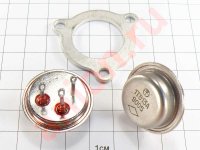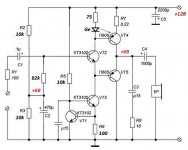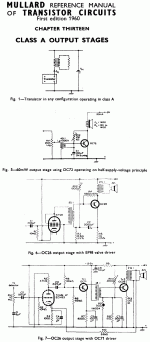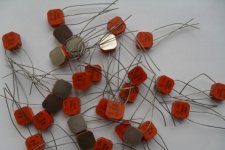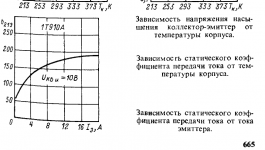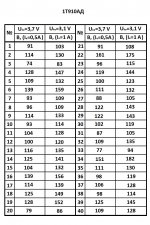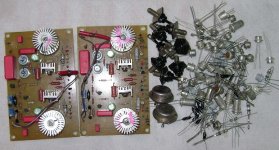You can order the production of PCB yourself:
Сirklotron with germanium transistors Darlington output. - Share Project - PCBWay
Circlotron with germanium transistors Shiklai output.. - Share Project - PCBWay
Сirklotron with germanium transistors Darlington output. - Share Project - PCBWay
Circlotron with germanium transistors Shiklai output.. - Share Project - PCBWay
P605 - Transistors from the USSR
1969 🙂
45v / 0.5a (1.5) / 10mhz / 3w - Burned like matches.
There were DIY quasi-complementary amplifiers (Lin) 6W / 8Ω.
The main application is mainframes (When computers occupied a large hall).
1969 🙂
45v / 0.5a (1.5) / 10mhz / 3w - Burned like matches.
There were DIY quasi-complementary amplifiers (Lin) 6W / 8Ω.
The main application is mainframes (When computers occupied a large hall).
P605 - Transistors from the USSR
1969 🙂
45v / 0.5a (1.5) / 10mhz / 3w - Burned like matches.
There were DIY quasi-complementary amplifiers (Lin) 6W / 8Ω.
The main application is mainframes (When computers occupied a large hall).
The most powerful germanium transistors in the USSR are 1T813B.
30A, 80 V, 50 W.
Attachments
I plan to use these for headphone amp, using 12ohm/42mH coils for load.
An analogue of the russian transistor KT3102 - BC546.
Attachments
Reading on russian forums I often encounter info, that Ge trannies like GT806 won't work in SE class A, yet my homebrewed amp works already for over a half year, with small copper heatsink, although fan cooled. Also I experimentally found out that for most of cases 20V supply is enough for me, but if I ever feel wild, I just up it to 35V.
An analogue of the russian transistor KT3102 - BC546.
Moi planned HP amp is much simpler, 100m 0,2mm wire air coil loaded emitter follower. If I need gain, 6n1p triode will do it. Currently I cannot drill my heatsink holes, so I will build it some time later.
Reading on russian forums I often encounter info, that Ge trannies like GT806 won't work in SE class A, yet my homebrewed amp works....
Of course it does. When even a Cadillac could only afford one transistor, they used it class A with a huge heatsink. Used far less battery/generator power than a couple of tubes plus the high voltage vibrator. I don't see my GE or RCA manuals just now, but here's Mullard 1960. 2 or 3 Watts out.
The 14V supply connections look odd because wired positive ground.
Attachments
Very beautiful indeed. Myself is having a trouble sleeping and chosing between simplified circlotron build vs inductor loaded SE version. 🙂 I wish I could build both for tri-amping purpose. Have to post-pone tho. Do you have DIY-friendly info about those interstage trafos? I wonder if one could use small power trafo and leave primary on, then just rewound secondary.
I can't even imagine how you can burn P605.
They are made on very reliable "conversion technology".
By the way, there is P605A, with more amplification.
In SE you can try 1T910AD.
Current 10 A, pulse - 20 A, voltage 32 V, collector power 35 W. Current gain in the range of 50-350. The gain increases monotonically to 20 A current (!!!) (second attachment). Frequency 30 MHz.
The third attachment is a pair selection table.
At two points: 0.5 and 1 A of emitter current.
They are made on very reliable "conversion technology".
By the way, there is P605A, with more amplification.
In SE you can try 1T910AD.
Current 10 A, pulse - 20 A, voltage 32 V, collector power 35 W. Current gain in the range of 50-350. The gain increases monotonically to 20 A current (!!!) (second attachment). Frequency 30 MHz.
The third attachment is a pair selection table.
At two points: 0.5 and 1 A of emitter current.
Attachments
Last edited:
Of course it does. When even a Cadillac could only afford one transistor, they used it class A with a huge heatsink.
I shopped for my tube amp parts in the local trash dump as a kid. Many of my solid state parts came from the auto junk yard, or even cars abandoned in vacant land.
Most cars had AM radios, and at that time the radios had no resale value, so they were cheap, or free. Old cars had tube radios, late 50's, early 60's had hybrid radios with 4 or 5 space charge tubes and one big germanium T0-36 transistor on the back mounted on a generous heat sink. By 62 or 63 most car radios were all solid state. The fat germanium transistor lived on until the late 60's I think.
The single ended class A radios used an output transformer to drive the speaker. My experiments in turning up the power on these amps revealed that 18 to 20 volts was the breaking point for most transistors. Of course I was a dumb kid who didn't understand things like bias, so the deaths were probably due to over dissipation.
I remember two numbers from those days, the 2N176 and the 2N441. Most were Motorola, Delco (GM) or Philco (Ford) branded. GM - Delco had their own fab, and made their own parts. They bought the rights to the Motorola MC6802 processor chip and made their own for engine controllers in the 80's.
I can't even imagine how you can burn P605.
They are made on very reliable "conversion technology".
By the way, there is P605A, with more amplification.
In SE you can try 1T910AD.
Current 10 A, pulse - 20 A, voltage 32 V, collector power 35 W. Current gain in the range of 50-350. The gain increases monotonically to 20 A current (!!!) (second attachment). Frequency 30 MHz.
The third attachment is a pair selection table.
At two points: 0.5 and 1 A of emitter current.
Thanks for share, I like Ge sound and I also like MOSFET characteristics, but I must admit that Ge played music is easier to tame in my psyche, while FETs are darker monsters that I only half - speak - to.
Is 1T910AD quite the best choice for SE? I was lucky to get a couple of GT806s for free from a local DIYer, but something more robust could be acquired in future. At the moment I am using very high resistance wirewound aircoils in my SE, and it naturally limits the current. For a price of output power. Perhaps there are other recommendations for high power Ge transistors?
2N1099
I also believe Pras1170 is having some of similar parameters, Pa recently took some specimens
I also believe Pras1170 is having some of similar parameters, Pa recently took some specimens
Last edited:
Last edited:
- Home
- Amplifiers
- Pass Labs
- Germanium investigations


